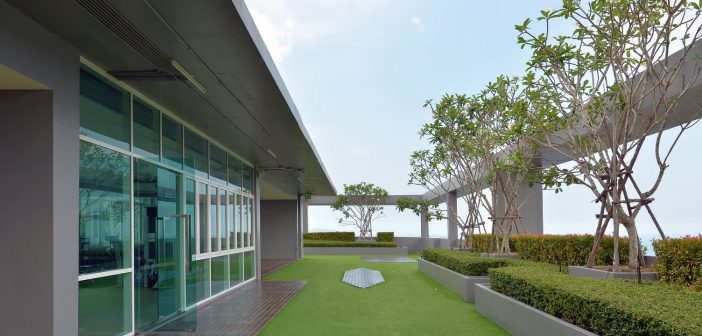What to look for and tips to follow for a pest-free hotel eco-roof.
Throughout major cities in the world, the struggle to increase green areas in a concrete landscape has proven difficult. To fix this, architects and landscape designers have joined forces to promote more greenery wherever possible in metropolises. From elaborate gardens to rooftop jungles, green roofs, also commonly known as eco-roofs, have taken urban areas by storm. Growing in popularity for their aesthetic appeal and ecological benefits, green roofs continue to gain popularity across the country.
With metro areas attracting many tourists, green roofs are a vital selling point to visitors looking for an escape during their vacation in the city. Many hotel guests are on vacation, and when not touring the city and sights, relaxing on a rooftop surrounded by vegetation and greenery is an experience like no other.
While green roofs create a sanctuary for guests, the vegetation is also a vacancy sign for pests. From birds to rodents to insects, your elevated paradise can quickly turn into an inconvenience for your guests. Unwanted critters are always on the search for shelter, food and water, which are all readily available thanks to your garden in the sky.
If your green roof is not properly maintained, both your guests and reputation could suffer. Widely-used review apps and websites allow for the hasty transfer of information, both good and bad. Through vigilance and a strong pest management program, green roofs can be a pleasant and safe environment for anyone who wants to enjoy them.
Below are some tips for keeping your green roof in tip top shape.
Be informed
Knowing the risks pests present to your hotel and guests is the first step to ensuring a pest-free establishment.
For your hotel, structural damage to your building can quickly become costly. Rodents are especially known to chew through electrical cords associated with lighting your rooftop patio. And if pests are on your roof, it’s possible they have already made their way through the building and confronted your guests. Rodents are able to fit through holes in the wall as small as a dime, so limiting exterior access points is essential.
In addition to structural damage, health hazards are also a main concern with pest infestations. Rodents and birds are significant carriers of disease-causing pathogens, such as salmonella, and bites or stings from insects can result in skin irritation and potential allergic reactions. The last thing you want is a guest to take a trip to the hospital after an unfortunate event on your green roof.
Know what to look for
Pests have easy access to outside green roofs, so keeping a watchful eye and implementing an examination routine of your green roof can help prevent a pest occurrence from becoming an infestation.
A few pests (and pest habits) to watch out for are:
- Carpenter ants, or other types of ants, are commonly found amongst vegetation on green roofs. A good sanitation routine will help reduce potential ant food sources on the green roof and keep populations in check.
- Birds, like pigeons, often roost in groups. Spotting multiple birds hanging out around your green roof might mean they are interested in making your roof their home.
- Cockroaches are lovers of mulch, and they can quickly run from intruders and go deep into the shavings. They also frequently leave droppings, which can range in size from grounds of pepper to small pellets.
- Mosquitoes love standing water and breed in small puddles or rain-filled flower pots. Their high-pitched buzzing and small larvae in shallow standing water can be easy signs you might have a pest problem.
- Earwigs are known to make their home in outside gardens, often travelling through potted dirt and mulch. Signs of these pests can range from damage to plants to actually seeing one.
- Rodents, like rats and mice, are occasionally easy to identify due to their pellet-sized droppings, burrows or nests they leave behind and gnawing marks on furniture, walls and electrical cords.
Make your green roof anti-pest
Implementing an integrated pest management (IPM) program is the most effective way to help prevent pest infestations, stopping them before they can become a much bigger issue. An IPM plan is an environmentally responsible solution to pest control that focuses on multiple control strategies, using chemical treatments as a last resort. A pest management provider will assess the green roof and the building’s weak points to develop a customized solution that both helps reduce pest activity and prevents pests from getting inside in the first place.
An effective plan will focus on exclusion, maintenance, sanitation, and both cooperation and teamwork between facility management and their pest management provider to protect against pests, with the specific challenges of a plant-filled roof in mind.
To keep these pests out, here are a few things that you can do:
- Check potted plants upon arrival to ensure the soil is pest free before moving it up to the garden.
- Routinely inspect and monitor trees and shrubbery to ensure pests aren’t making your paradise their home.
- If guests take drinks to the roof, or if your green roof has a bar, monitor and clean spills immediately.
- Routinely clean green roof patio areas of any food crumbs that might be attractants to birds and rodents.
- Wipe down and sanitize patio furniture such as tables and benches to help repel pests from exploring your furniture.
Rain can also be a factor to consider when scheduling check-ups. Heavy, consistent rain can leave pots filled with water, which should be emptied to avoid water-loving pests.
Green roofs can add a lovely aesthetic to any building, so monitoring for pest infestations is important. A pest management professional can schedule staff trainings to teach cleaning and maintenance crews the signs of pest activity and practical, everyday strategies for combatting pest-conducive conditions.
By taking a proactive approach, you can ensure that your green roof is the coveted luxury it should be for your guests.




